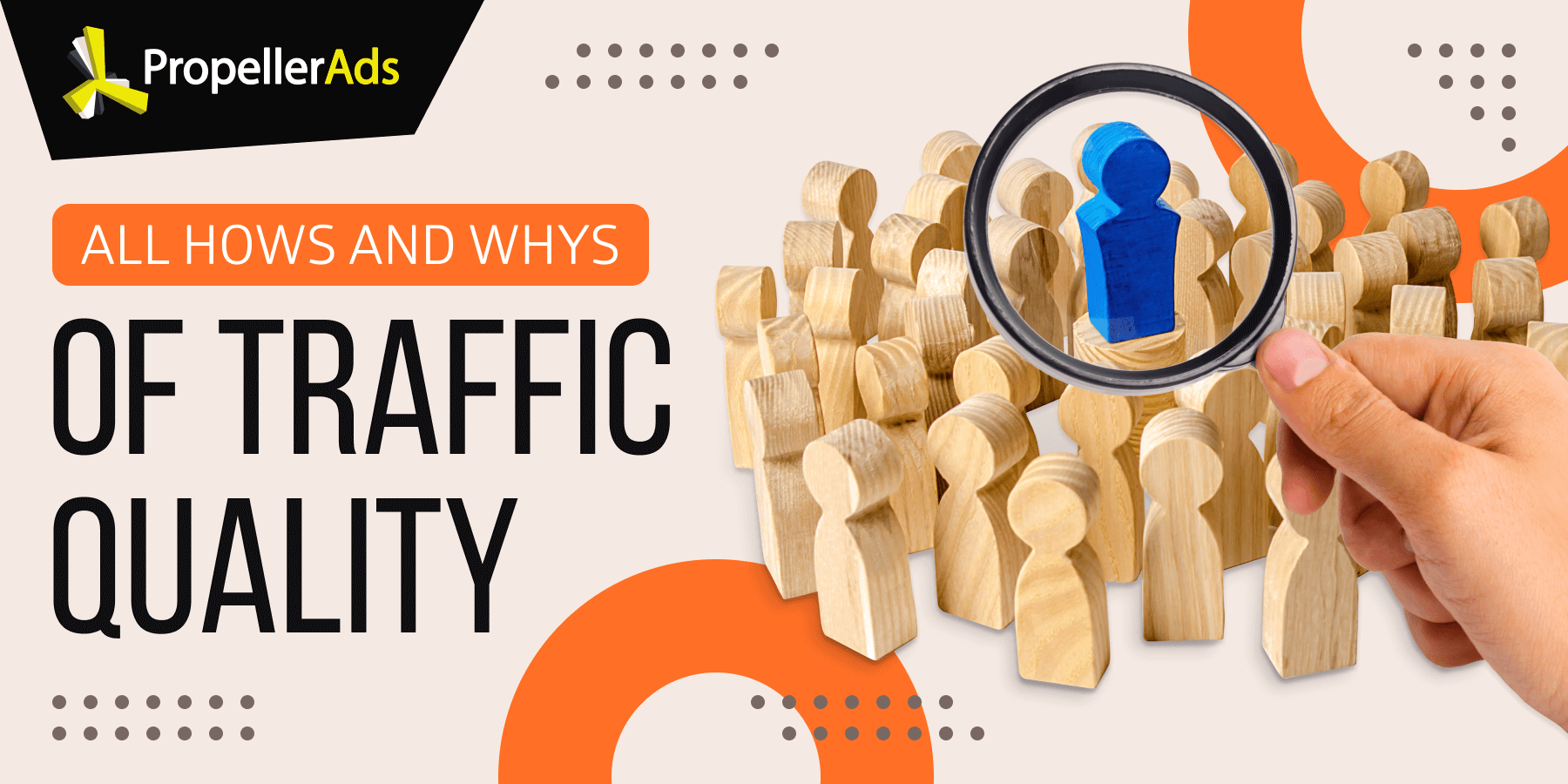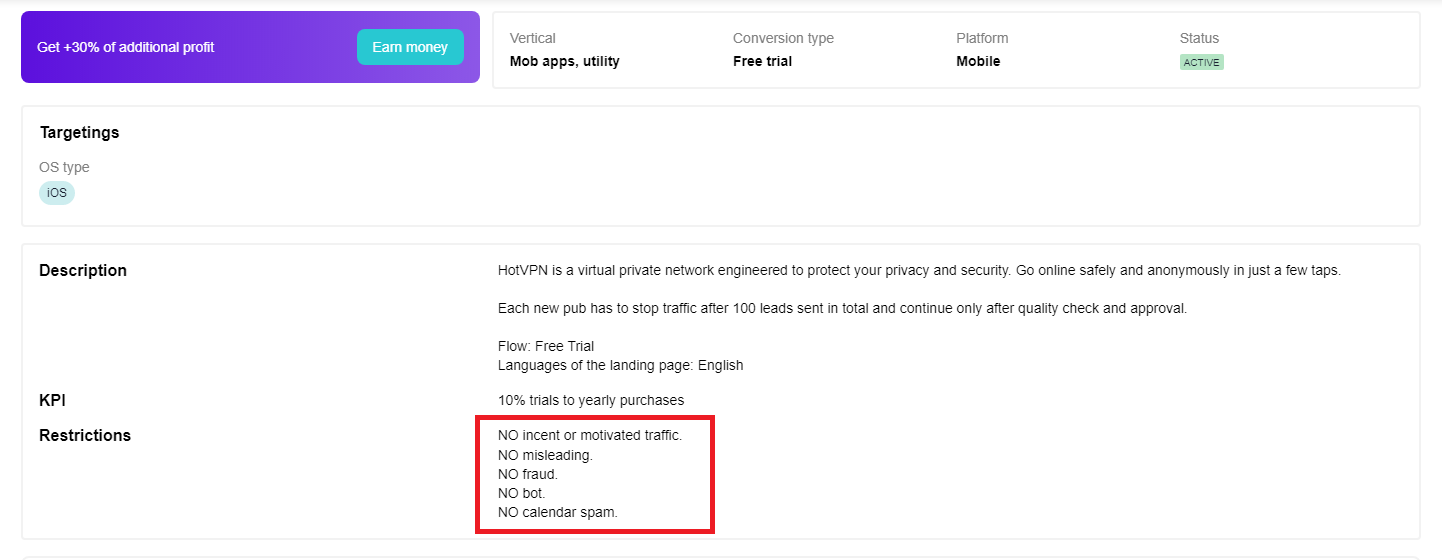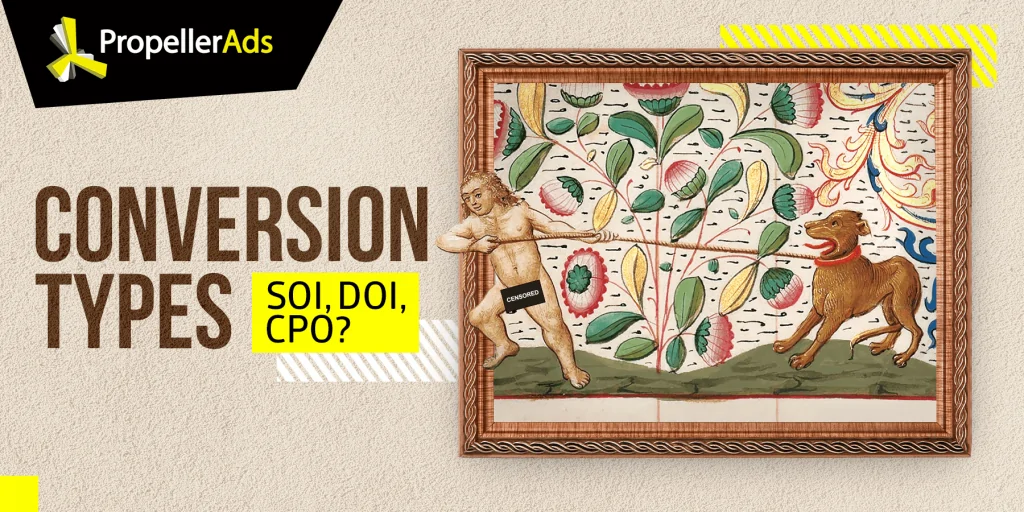Traffic Quality: How to Get the Best Users [Case Study Inside!]

This post is also available in:
PT
As an affiliate marketer, you constantly hear these magic words: ‘Only high-quality traffic required’, ‘Always check and improve your traffic quality’ — and so on.
But what exactly is the traffic quality, and how can you measure and control it?
What is traffic quality and what can affect it?
The first thing that pops into your mind when you hear about the traffic quality is probably conversions. Well, it’s basically correct: high-quality traffic is the one that converts well.
You’ll say:
Okay, I have a 100% conversion rate — my traffic quality is perfect, right?
And the answer is
Not always.
How can it be? There are two reasons why high conversion rates do not necessarily indicate how good your traffic is.
Elaborated Fraud
Suppose you run some Utility offer and get paid per single app installation. You see that the offer converts greatly and users do install the app. However, later, it turns out that most of these conversions were made by very exquisite bots: so elaborated, that they completely mirrored human behavior.
Obviously, such app installs won’t bring any profit to the offer owner in the future — they were not even from the real users!
What do we have then? A good traffic volume, nice conversion rates — and very, very poor traffic quality.
So, your CR doesn’t always show your traffic is good enough.
Offer Terms
Another question you need to ask yourself about your traffic quality is what the CPA network expects from you. Luckily, most offers contain very transparent rules and you have clear guidelines of what you can and can’t do. Here is an example:

In this example, the rules are pretty common and obvious. However, some direct advertisers can go further when they evaluate the traffic you brought to their offers.
For example, you promote some iGaming offer with FTD (First-Time Deposits) conversions. You need your users to make the first deposit and that’s it. Still, an advertiser expects these users to deposit regularly — long after the advertising campaign is over.
If you brought, say, 150 first deposits, and only one of these users continued investing money in this iGaming site — your traffic quality turns out not to be the best one, after all.
Such a situation is not usually the reason for any refund claims — but it may somehow affect your reputation as an affiliate marketer.
Overall, every advertiser has their own views on the traffic quality and your goal is to meet their expectations.
So, what is the conclusion after all?
Good, high-quality traffic is the traffic that brings clean no-fraud conversions and meets the offer needs. Bad traffic is mainly bot and fraud traffic — even if it converts.
Okay, but how can you guess if your traffic is good or bad?
Measuring Traffic Quality
Luckily, you don’t need to guess anything: thanks to Google Analytics, you can get a very precise estimation. Here are several metrics you might want to check to measure your traffic quality.
Bounce Rate
Bounce Rate shows the percentage of users who leave your page almost instantly. The bounce rate can vary from 20% (excellent!) to 70% (pretty average), so statistics for a couple of days won’t give you much information.
Besides, the Bounce Rate might significantly vary depending on your traffic type. For instance, Popunder ads usually result in much higher bounce rates than, say, Push ads.
To get the most out of the bounce rate metrics, watch it over time. If you see your bounce rate goes higher and higher as the campaign flows, it might mean you are bringing in irrelevant traffic and wasting much of a budget.
Visit Duration
This one seems pretty obvious: visit duration is the time a user spent on your page. The trick is that longer or shorter duration can be both good and bad in terms of traffic quality.
A relevant user can stay on your page for just a few seconds before they convert. And the same relevant user can scroll your page for about a minute and then leave — just because they didn’t get your message or CTA.
The Visit Duration metric is very individual, so don’t estimate it separately from the other metrics.
New Visits
New Visits metric allows you to see if your campaign keeps attracting unique users. Again, be careful with this metric: quantity doesn’t always mean quality. Check this metric alongside your conversion rate: do your new users convert or not?
If you see that your new visits turn into a good conversion rate, it most likely means you are scaling your campaign with relevant high-quality traffic.
Bots Excluded
You obviously don’t want to count fraud traffic in your analytics: we are striving for real unique users, right?
To exclude bots from your Google Analytics stats, just go to the View Settings in your account and press the ‘Exclude all hits from know bots and spiders’.
Improving Traffic Quality: Issues and Tips
So, you now know what to consider good or bad traffic. Your next step is to prevent your traffic from any signs of poor quality. It’s obviously somehow related to optimizing your campaigns — but what exactly should you look at?
Choosing the right network
The first and probably the most essential point is to be sure that you are receiving traffic from reliable sources. You can spend hours optimizing your campaigns — but it all dies in vain if your network provides you with cheap, low-quality users.
At PropellerAds, we guarantee that we use top-notch sources. Our traffic works especially well when it comes to the 3-Tier traffic and such verticals as iGaming, Finance, Utilities, Gaming, and Sweepstakes.
Traffic Tokens
Using dynamic tags, or traffic tokens can give you a hint on how to improve your traffic quality. We speak precisely about the {zoneid}: it can help you see the most converting zones with the cleanest traffic.
A particular zone might turn out to bring you low-quality traffic: full of bots, or simply irrelevant. Just switch it off then — and your efforts might become significantly better!
Direct Click
If you are not very happy with your conversions, try Direct Click — a traffic type that was specially created to bring you the most relevant users.
Direct Click stats also show you the top-converting zones — and it opens new horizons for testing!
Interest Targeting
Another strategy for getting more high-quality traffic involves targeting settings. For instance, you run a campaign and see your traffic doesn’t convert well. After some research you get more precise information about the target audience: for instance, it’s men of a certain age.
Try purchasing some more traffic for this precise audience — and you are likely to get relevant leads.
Testing Formats
Suppose you run a campaign and see that your traffic is not satisfactory enough. Try switching to another format!
For example, you run a Popunder campaign with a Free Trial conversion. The Popunder format is user-friendly, but can sometimes attract not-so-relevant traffic. We mean, with Popunder, a user can impulsively install an app — to never open it again, not saying of purchasing a paid version.
It’s not that usual issue, in fact. But what can you do if it happens too often?
Start the same campaign with Push traffic! It’s probably the least intrusive way of showing ads — and users coming from Push notifications, are much more conscious. In other words, there’s a much bigger chance they install the app because they really need it.
Creatives
There are two things you need to know about creatives when you are striving for top-quality traffic. Here they are:
- Don’t rely on CTR
The creative’s high CTR doesn’t always mean it brings good traffic. For example, you added some very clickable Interstitials promising a user to instantly win money. It’s pretty likely that people will click on it! But will they convert after they find themselves at a completely irrelevant pre-lander asking them to take a bank loan?
- No misleading creatives
And, pretty logically, we can give you another tip for your creatives: don’t allow them to be misleading! It will have a high CTR but will bring tons of irrelevant — and thus low-quality traffic with no conversions.
In other words: don’t let such a push ad:
Lead to a page like that:
Got the concept?
What is more, misleading creatives are prohibited by PropellerAds policies and most CPA offer owners — exactly because they result in irrelevant traffic. So, mind your messages, don’t exaggerate users’ profit, and be honest with them.
Anti-Fraud Solutions
Finally, fraud and bots — mishaps that cause the majority of traffic you can call ‘bad’. How to beat them? We have two solutions that will help minimize sneaky impersonators affecting your campaigns.
- PropellerAds In-House Anti Fraud System. Thanks to our top-notch technologies, we efficiently detect and beat bot traffic. In fact, you can be pretty sure that your campaigns won’t be attacked by fraudsters when you run your campaigns in our SSP.
- ADEX Anti-Fraud Tool. If you want to go further and protect yourself on the highest level possible, try using an extra tool. Our partners ADEX suggest a very powerful system that detects even the most exquisite bots — and allows you to check your traffic quality in real-time.
How Do I Know That I Improved My Traffic?
So, you applied a couple of tips above. How to know that it worked out? Obviously, you will need to check out the stats again — and see what if anything changed.
Track and compare the changes in the metrics we mentioned:
- Bounce Rate
- New Visits
- Visit Duration
- Conversions
They might change depending on your offer, traffic type, your landing page, and any other optimizations you made.
The best way to get the idea of how you improved your traffic is to set your own goals relying on either some industry-average numbers or metrics for a particular offer.
And, of course, mind the conversions: even a lower CTR and a smaller amount of visits can result in a better conversion rate. Yes, you might start receiving fewer users and conversions overall, but you will be sure that you are bringing valuable and profitable traffic.
To sum up and make things clearer, we will share a very vivid case study.
Bonus Part: Case Study
Our partners ran an Investment Platform offer. The flow was simple enough:
| Desktop | Mobile |
| Conversion: Cost-Per-Lead A user sees a pre-lander and registers at the platform | Conversion: Cost-Per-Install A user downloads the Investment Platform’s app |
What’s important here? A conversion doesn’t mean profit for the offer owner in this case. A user can install an app, but never open it and make any deposits. So, high-quality traffic implies relevant conversions — from the users who are really interested in the Finance vertical.
In such campaigns, there can be 1000 conversions (registrations or app installs) and only, say, 10 first deposits. So, the conversion is not the end of the whole sales funnel!
Long story short, the desktop and mobile campaigns were launched. They were also divided by GEOs: India, Nigeria, Indonesia, and more. The partner decided to test Push and Interstitial formats at first.
After some tests, it became clear that the traffic is not the best one. Although the partner got a pretty large number of conversions, these users didn’t make their first deposits afterward.
Look at the stats for the campaign’s main GEO, India:
| Country | Impressions | Clicks | Conversions |
| IN | 719 083 736 +239 829 119 | 5 652 115 +2 503 813 | 20 198 +6 027 |
Despite very impressive numbers, most of the conversions just went to waste. The users willingly installed an app or registered at a site, but wouldn’t deposit a buck.
So, what did our partner do to improve it?
- Switched to the In-Page Push and Popunder traffic formats. They immediately started bringing more conversions from really engaged users
- Created White- and Blacklists for different GEOs
- Tested various creatives to find the most converting ones
- Changed GEO targeting: set Targeting by regions within each country
- Set the Interest targeting to reach users interested in Finance
- Added a new campaign with much more narrow targeting. This campaign included the top converting OS versions, regions, and browsers — and several versions of a pre-lander
And, here are the new stats:
| Country | Impressions | Clicks | Conversions |
| IN | 214 191 750 -156 008 152 | 353 529 -2 614 936 | 55 745 +18 921 |
It might not be really obvious why these stats are better than the previous ones.
A more detailed look at the other metrics can give you a hint, though:
- The pre-landers started to get fewer new visits: only interested users clicked the ads
- The visit duration became a bit longer: the users were pretty engaged and wanted to check out the offer thoroughly
- The bounce rate went significantly lower: there were fewer users who immediately found the offer irrelevant
And, the most important: despite a smaller number of impressions and clicks, the number of conversions went higher! It means that the partner began to attract fewer visitors but they were the ones who really needed the offer.
In other words, these users became this high-quality traffic we are speaking about.
What is more, the conversions started turning into deposits much more often. So, it was clear that all the optimization effort worked more than great — even though we see red colors in the stats.
TL;DR: Traffic Quality Checklist
In short, PropellerAds is always on the lookout for your traffic quality. Let’s sum up what you can do to make sure you receive clean, relevant traffic that brings conversions:
- 1. Choosing the right network that works with reliable publishers
- 2. Using anti-fraud systems
- 3. Optimizing campaigns and excluding poor-quality traffic zones
- 4. Checking and comparing results throughout the whole time when your campaign is live
And, now that you are armed with the best practices of how to deliver the highest quality traffic —









